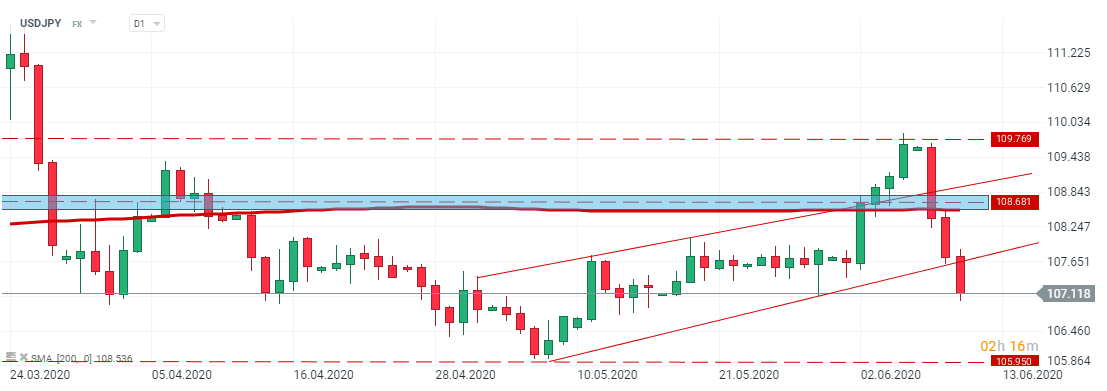• Nasdaq hit new all-time high
• Fed keeps rates unchanged
• Powell says Fed isn't even thinking of raising rates
Mixed moods persisted on the markets today. Major European indices erased earlier gains and finished lower. According to Reuters' report, ECB is working on a scheme to cope with unpaid euro debt due to the coronavirus crisis. DAX 30 lost or 0.5%, CAC declined 0.8% and FTSE 100 finished 0.1% lower.
US indices swung between gains and losses during today’s session. Federal Reserve has decided to leave interest rates unchanged and pledged to increase its balance sheet at least the “current pace” which is about $80 billion per month. This means that the FED will maintain its current ultra-expansive policy even if the economic situation improves. Also Policymakers projected a 6.5% decline in gross domestic product this year and a 9.3% unemployment rate at year's end. FED is not planning to increase interest rates through 2022. During the press conference, Chair Powell said that FED will continue to use its powers forcefully, aggressively and proactively. Policymakers will put tools back in the toolbox 'after the crisis has passed'. Powel confirmed that in the near future Fed does not see any chance of raising interest rates “We’re not thinking about raising rates. We’re not even thinking about thinking about raising rates,” Powell said. “What we’re thinking about is providing support for the economy. We think this is going to take some time.” It is important that the Fed will address the issue of targeting relevant yields on the yield curve. “Fed also reviewed yield curve control at its latest policy meeting, its effectiveness still an open question." Powell avoided the question of whether the recent rally led to a potential bubble in the markets. S&P 500 and DJIA remain lower than yesterday, while Nasdaq maintains high levels. Today's statement by the Fed chairman weakened the US dollar slightly. Information on record low interest rates that will persist over the next 2.5 years supports precious metals. Gold rose over 1% and silver is trading 3% higher.
EIA informed that US crude inventories rose sharply to 5.7 million barrels while analysts’ expected a 1.7 million barrels decline. Inventories fell 2.1 million barrels in the previous week. Despite this negative news oil prices were steady on Wednesday, paring earlier losses. WTI is trading above $ 39.00 per barrel and Brent managed to stay above $ 41.00 per barrel.
Looking at the valuations of the US technology companies, it would be hard to guess that we are currently dealing with one of the largest financial crises in history. Nasdaq records new historical highs, clearly above 10,000 points, fueled by the largest US technology companies. In 2015, when the index broke above 5,000 points, which was the historic high of the dot-com bubble, many investors claimed that stock prices would fall again. However, since then the index has risen 100%. It seems to be an unimaginable achievement. However, after reaching such a level in just 5 years, why not measure higher? For example up to the level of 15,000 points. Is something standing in the way?
Currently we're dealing with ultra-cheap money right now. The Federal Reserve runs many non-standard monetary policy programs. Other central banks follow FED’s footsteps. In addition, further fiscal programs are already being discussed in the United States. The Fed is currently implementing a new loan program addressed directly to enterprises with deferred interest and capital repayments. Moreover, current economic data show that the situation should improve in the second quarter of this year. Of course, if the situation gets worse, also in terms of epidemics, further actions can be expected. However, as many experts indicate, we should no longer take into account another shutdown of the global economy in the event of the second wave of infections, as this would lead to the largest economic collapse in history, the effects of which would be felt for decades.
US unemployment claims will be the main macroeconomic release scheduled for Thursday. Investors will also get to know PPI figures from the US and SNB Financial Stability Report. Also Eurogroup Meetings will take place tomorrow.
![]() USDJPY managed to broke below the upward channel and has fallen to a three-week low. If sellers manage to push the price lower, then support at 105.95 may come into play. On the other hand, breaking above the resistance at 108.68 will invalidate the bearish scenario and the market may launch another upward impulse toward 109.76. Source: xStation5
USDJPY managed to broke below the upward channel and has fallen to a three-week low. If sellers manage to push the price lower, then support at 105.95 may come into play. On the other hand, breaking above the resistance at 108.68 will invalidate the bearish scenario and the market may launch another upward impulse toward 109.76. Source: xStation5
 USDJPY managed to broke below the upward channel and has fallen to a three-week low. If sellers manage to push the price lower, then support at 105.95 may come into play. On the other hand, breaking above the resistance at 108.68 will invalidate the bearish scenario and the market may launch another upward impulse toward 109.76. Source: xStation5
USDJPY managed to broke below the upward channel and has fallen to a three-week low. If sellers manage to push the price lower, then support at 105.95 may come into play. On the other hand, breaking above the resistance at 108.68 will invalidate the bearish scenario and the market may launch another upward impulse toward 109.76. Source: xStation5
